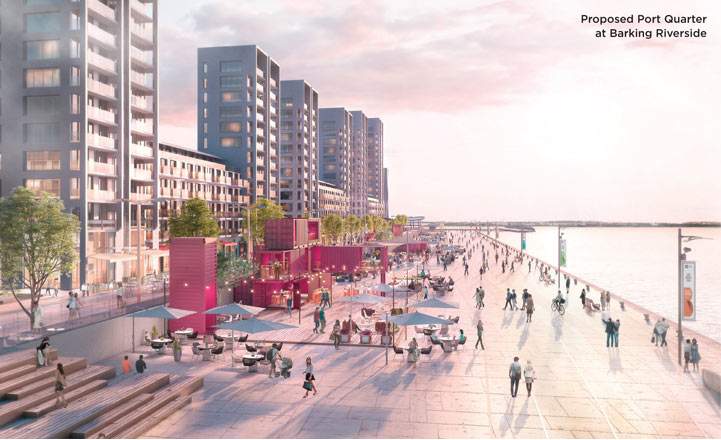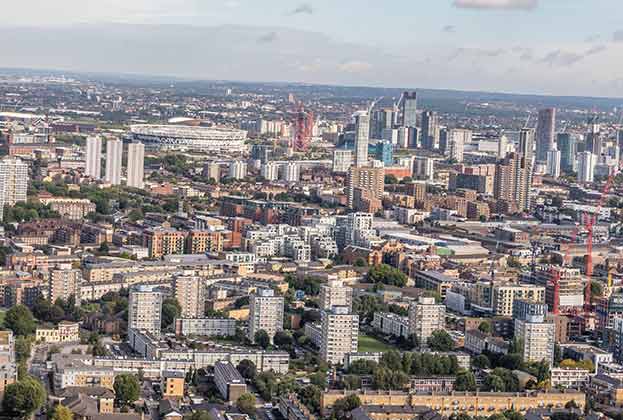Is current supply meeting demand?
Households that have moved into new build properties in East London in recent years tend to have moved from local areas, and on average moved just 1.5 miles. While 79% of all movers have come from within London, there has been demand from areas just outside the London border, from Purfleet and Chafford Hundred, and further east from Chelmsford. Nearly two thirds of movers were under the age of 40, though this comes with variation by borough; 72% of movers into Tower Hamlets were under the age of 40, compared to just 58% in Waltham Forest.
Just under two thirds of all households moving into East London can be grouped into two household groups, and four household types. City Prosperity households, generally very successful and high-earning individuals, tended to move into Hackney, Newham, Tower Hamlets and Waltham Forest. Rental Hubs, younger professionals generally at the start of their careers, were more inclined to look to the three most eastern boroughs, in search of more affordable well-connected areas.
The challenge of post Help to Buy
There is no doubting the influence Help to Buy (HtB) has had in maintaining the new build sales market in London, particularly since the 40% equity loan was introduced in Q2 2016. Since then, the number of HtB sales in London has increased threefold, now making up around a third of all new build sales in London. Tower Hamlets has seen the largest number of HtB sales in the year to Q3 2019, with Waltham Forest and Newham also in the top six London boroughs.
The scheme has also been pivotal in encouraging development. Since Q2 2016 the number of HtB loans as a proportion of new home EPCs is 43% in Havering, and 31% in Barking and Dagenham. First Homes will undoubtedly be important in the boroughs where HtB has been so important. Boroughs such as Tower Hamlets and Barking and Dagenham are among the few areas in London where the First Homes policy could work, making homes affordable to more buyers without requiring steep discounts that would affect the site viability.
Naturally, this raises the question of the impact on the market once the current Government commitment to the scheme ends in 2023. The overleaf charts group the new build sales numbers by transaction value in the year to November 2019 in inner and outer East London boroughs. Two median inner London salaries would only have been able to afford 27% of new build properties that transacted without HtB, assuming they have a 25% deposit.

In the outer East London boroughs, there is less of a reliance on HtB, as over half of new build sales would have been affordable for two outer London median earners without the scheme.
What homes need to be built?
Analysis of local household incomes and current stock shows a significant affordability gap in East London. Assuming households spend 30% of their income on housing costs, there is a lack of housing supply for those earning between £20,000 and £45,000, and a clear opportunity to plug the gap.
According to Experian, there are three main household types that fall within this income band; ‘Flexible Workspace’ who are successful, young renters, ‘Culture & Comfort’ households who are thriving families in diverse suburbs with good incomes and ‘City Diversity’ who are families that tend to be renting social flats in city suburbs. Therefore, there will be demand for different types of product.
The latter will most likely require some form of affordable housing big enough for families with children, whereas the former will look for one or two bedroom flats as potentially their first step on the housing ladder. Mortgage borrowing restrictions would also suggest There is be significant demand for intermediate product such as Shared Ownership or First Homes when Help to Buy comes to an end.
Depth of market in inner East London
(Hackney, Newham, Tower Hamlets)
.jpg)
Source: Land Registry, ASHE. Assumes 4.5 LTI, 2 median earners and a 40% HtB equity loan
Depth of market in outer East London
(Barking & Dagenham, Havering, Redbridge, Waltham Forest)
.jpg)
Source: Land Registry, ASHE. Assumes 4.5 LTI, 2 median earners and a 40% HtB equity loan
The role of Build to Rent
The Build to Rent (BTR) sector has seen significant institutional investment in the past few years, making up 26% of all London’s new build sales, as recorded by Molior, in 2019, up from just 10% in 2014. There are over 7,000 complete BTR homes in East London, with a further 6,500 under construction and 13,000 in planning.
Nearly three quarters of East London BTR completions have been in Newham or Tower Hamlets, with areas such as Stratford and Canary Wharf already seeing significant levels of BTR activity. Cherry Park at Stratford which will see 1,224 BTR homes delivered is currently under construction, whilst to the south, Limmo Peninsula and TwelveTrees Park are in planning and each could potentially deliver over 1,000 BTR homes.
Canary Wharf Group’s new BTR arm, Vertus, saw residents move into their first BTR building at 10 George Street in February. The 37 storey tower sits at the heart of Canary Wharf and has been letting very well in its early stages. With flexible tenancy terms and deposit options, 10 George Street may well raise the bar for what tenants come to expect from a BTR development. Vertus is set to introduce two more rental schemes to the market this year, at its Water Street development and Newfoundland.
Conversely, the potential of areas like Ilford, which sees similar proportions of private renters, remains relatively untapped by institutional investors. With prospective renters being sensitive to connectivity to employment hubs, there is potential for the BTR sector to grow in these areas once the fully operational Crossrail provides improved connectivity further east, and take advantage of the increasingly transient rental population in London.
From a wider viewpoint, with the end of HtB in sight, the BTR sector can go a long way to filling in the anticipated void.
Summary
East London is a popular destination for successful, relatively young inner-city workers in recent years, with Stratford and Tower Hamlets being popular destinations for these households. Help to Buy has played a significant role in supporting new build sales, and also in encouraging delivery in the outer boroughs of the Eastern Corridor. Once government commitment to the current scheme ends, Build to Rent, and, no doubt, the impending First Homes will all play a role in plugging the gap.
Read the other articles within London Development: Eastern Corridor below
.jpg)
